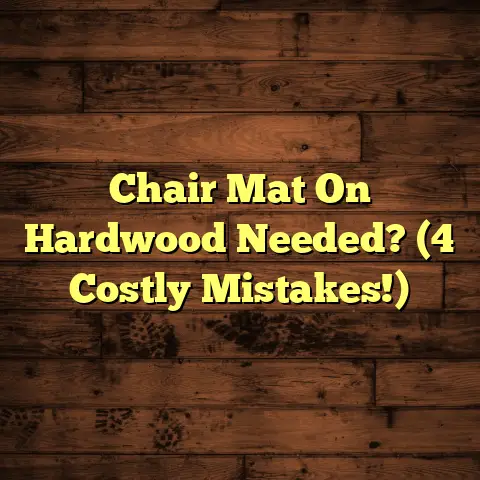Cut Thick Vinyl Plank? (1 Tool Will Ruin It!)
And let me tell you, nothing’s more frustrating than watching someone ruin a beautiful flooring project because of one simple mistake: using the wrong tool.
Home renovations are booming, aren’t they? It seems like everyone’s eager to upgrade their spaces, and flooring is often at the top of the list.
And one flooring type that’s gaining massive popularity is vinyl plank flooring, especially the thicker stuff.
According to a report by Grand View Research, the global vinyl flooring market is expected to reach $49.73 billion by 2028. That’s a lot of vinyl!
Thick vinyl plank is a favorite because it’s durable, looks fantastic, and is relatively easy to install. But here’s a secret: easy doesn’t mean foolproof.
Section 1: Understanding Thick Vinyl Plank Flooring
So, what exactly is thick vinyl plank flooring?
Simply put, it’s vinyl flooring that’s thicker than your average sheet vinyl or standard vinyl tile. We’re usually talking about planks that are 5mm or thicker, sometimes even reaching 8mm or more.
These planks are typically made from multiple layers:
-
Wear Layer: This is the top layer that protects the plank from scratches, dents, and wear and tear.
-
Vinyl Layer: This layer provides the plank’s design and color.
-
Core Layer: This is the heart of the plank, providing stability and rigidity. It can be made from different materials like WPC (wood-plastic composite) or SPC (stone-plastic composite).
-
Underlayment (Often Attached): Some thick vinyl planks come with pre-attached underlayment for added comfort and sound insulation.
Why go thick? Well, the advantages are numerous:
-
Comfort: Thicker planks feel softer and warmer underfoot.
-
Sound Insulation: They absorb sound better than thinner options, reducing noise transmission. I’ve had clients in condos specifically request thicker planks for this reason.
-
Durability: They’re more resistant to dents and scratches, making them ideal for high-traffic areas.
-
Longevity: With proper care, thick vinyl planks can last for decades.
You’ll find a few different types of thick vinyl planks on the market:
-
Luxury Vinyl Tile (LVT): These come in various shapes and sizes, often mimicking the look of natural stone or ceramic tile.
-
Rigid Core Planks (SPC/WPC): These have a super-rigid core, making them extremely durable and water-resistant. SPC is particularly tough!
Section 2: The Importance of Proper Cutting Techniques
Now, let’s talk about cutting. Why is it so crucial?
Well, unless you’re flooring a perfectly square and empty room (which almost never happens), you’re going to need to cut planks.
Think about it:
-
Corners: Every room has them!
-
Doorways: Need to fit around the jambs and casings.
-
Obstacles: Pipes, cabinets, oddly shaped walls – the list goes on.
Cutting vinyl planks isn’t just about making them fit. It’s about achieving a professional, seamless look.
Imagine spending hours installing beautiful new flooring, only to have it ruined by jagged edges and uneven seams.
The consequences of improper cutting can be significant:
-
Damaged Planks: Chipped edges, cracked cores, and ruined designs.
-
Poor Fitting: Gaps, overlaps, and uneven surfaces.
-
Aesthetic Issues: An unprofessional and unfinished look that detracts from the overall beauty of your floor.
I once had a client who tried to install vinyl plank flooring themselves and ended up with gaps so large you could see the subfloor. They had to rip it all out and start over!
Section 3: The One Tool That Can Ruin Thick Vinyl Plank
Alright, drumroll please… the one tool that can absolutely ruin thick vinyl plank is a standard utility knife.
I know, I know, it seems like the obvious choice. It’s sharp, readily available, and you probably already have one in your toolbox.
But here’s the thing: thick vinyl plank is thick.
That little utility knife blade just isn’t designed to handle the density and rigidity of these planks.
A common misconception is that you can simply score the plank multiple times with a utility knife and then snap it.
While this might work on thinner vinyl, it’s a recipe for disaster with the thicker stuff.
Here’s why:
-
Inconsistent Scoring: It’s difficult to maintain a consistent depth and pressure when scoring, leading to uneven breaks.
-
Core Damage: The core of thick vinyl plank is often very dense. A utility knife can crush or splinter the core instead of cutting it cleanly.
-
Risk of Injury: Applying excessive pressure to a utility knife can cause the blade to slip, resulting in cuts and injuries. I’ve seen it happen!
-
Wasted Time: You’ll spend more time trying to wrestle with the plank than you would using the right tool.
The mechanics are simple: the utility knife blade is too thin and flexible to effectively cut through the dense core.
It tends to tear and rip rather than slice cleanly, leaving you with a jagged, unprofessional edge.
Section 4: Alternative Tools for Cutting Thick Vinyl Plank
So, if a utility knife is a no-go, what should you use?
Here are my top recommendations for cutting thick vinyl plank:
-
Vinyl Plank Cutter: This is my go-to tool for straight cuts. It’s specifically designed for vinyl plank flooring and provides clean, precise cuts with minimal effort.
-
Advantages: Fast, clean cuts; minimal dust; quiet operation.
-
Proper Usage: Place the plank on the cutter, align the blade with your mark, and press down firmly on the handle.
-
-
Miter Saw: For angled cuts and more complex shapes, a miter saw is your best friend.
-
Advantages: Precise angled cuts; can handle thicker planks; versatile.
-
Proper Usage: Use a fine-tooth blade designed for cutting plastic or laminate. Secure the plank firmly and make slow, controlled cuts.
-
-
Jigsaw: A jigsaw is great for cutting curves and intricate shapes.
-
Advantages: Versatile; can cut curves and circles; relatively inexpensive.
-
Proper Usage: Use a fine-tooth blade designed for cutting plastic. Apply painter’s tape to the cut line to prevent chipping.
-
I remember one job where I had to install vinyl plank around a curved staircase. A jigsaw was the only tool that could handle the complex cuts required.
Here’s a quick testimonial from a fellow contractor, Mark, who swears by his vinyl plank cutter:
“I used to struggle with utility knives and ended up with so many ruined planks. Since switching to a vinyl plank cutter, my cuts are cleaner, faster, and I waste way less material.”
Section 5: Step-by-Step Guide to Cutting Thick Vinyl Plank Correctly
Alright, let’s get down to the nitty-gritty. Here’s a step-by-step guide to cutting thick vinyl plank properly:
Step 1: Measure and Mark
- Measure the area where you need to cut the plank. Use a tape measure and a pencil for accuracy.
- Transfer the measurement to the plank, using a straight edge to draw a clean, straight line.
- Double-check your measurements before cutting!
Step 2: Choose the Right Tool
- For straight cuts, use a vinyl plank cutter.
- For angled cuts, use a miter saw.
- For curves and intricate shapes, use a jigsaw.
Step 3: Cutting with a Vinyl Plank Cutter
- Place the plank on the cutter, aligning the blade with your marked line.
- Ensure the plank is firmly seated on the cutter.
- Press down firmly on the handle to make a clean, straight cut.
Step 4: Cutting with a Miter Saw
- Set the miter saw to the desired angle.
- Secure the plank firmly against the fence.
- Turn on the saw and slowly lower the blade into the plank, following your marked line.
- Maintain a steady hand and avoid forcing the blade.
Step 5: Cutting with a Jigsaw
- Apply painter’s tape to the cut line to prevent chipping.
- Secure the plank to a workbench or other stable surface.
- Turn on the jigsaw and slowly guide the blade along your marked line.
- Use a steady hand and avoid pushing the saw too quickly.
Tips for Clean Cuts:
- Use sharp blades. Dull blades can cause tearing and chipping.
- Cut slowly and steadily. Avoid rushing the process.
- Use a dust collection system to keep your work area clean.
Here’s a visual to help you visualize the process:
[Insert Image Here: A collage showing the proper use of a vinyl plank cutter, miter saw, and jigsaw on thick vinyl plank]
Section 6: Common Mistakes to Avoid When Cutting Vinyl Planks
Okay, let’s talk about some common pitfalls and how to avoid them:
- Using a Dull Blade: This is a surefire way to get jagged edges and splintered cores. Always use a sharp blade, and replace it regularly.
- Rushing the Cut: Patience is key! Take your time and focus on making a clean, precise cut.
- Not Measuring Accurately: Double-check your measurements before cutting. It’s better to be slightly too long than too short.
- Forcing the Tool: Let the tool do the work. Don’t force it, or you risk damaging the plank or injuring yourself.
- Not Using Safety Gear: Always wear safety glasses and hearing protection when using power tools.
I once saw a DIYer try to force a dull utility knife through a thick vinyl plank. The blade slipped, and they ended up with a nasty cut on their hand. Not fun!
Here’s another real-life example: a client tried to save time by skipping the measuring step and just “eyeballing” the cuts. Needless to say, the flooring looked terrible, and they had to redo a significant portion of the project.
Section 7: Conclusion
So, there you have it! Cutting thick vinyl plank flooring doesn’t have to be a daunting task.
By understanding the importance of proper cutting techniques and using the right tools, you can achieve a professional, beautiful finish that will last for years to come.
Remember, the key takeaway is to avoid using a standard utility knife on thick vinyl plank. It’s simply not designed for the job and can lead to damaged planks, poor fitting, and a less-than-professional look.
Invest in a vinyl plank cutter, miter saw, or jigsaw, and you’ll be well on your way to a successful flooring project.
Now, I’d love to hear from you! Have you ever had a flooring project go wrong because of the wrong tools? What are your favorite tips and tricks for cutting vinyl plank?
Share your experiences in the comments below! And if you’re looking for more information on vinyl flooring installation, don’t hesitate to reach out. I’m always happy to help.
Happy flooring!





